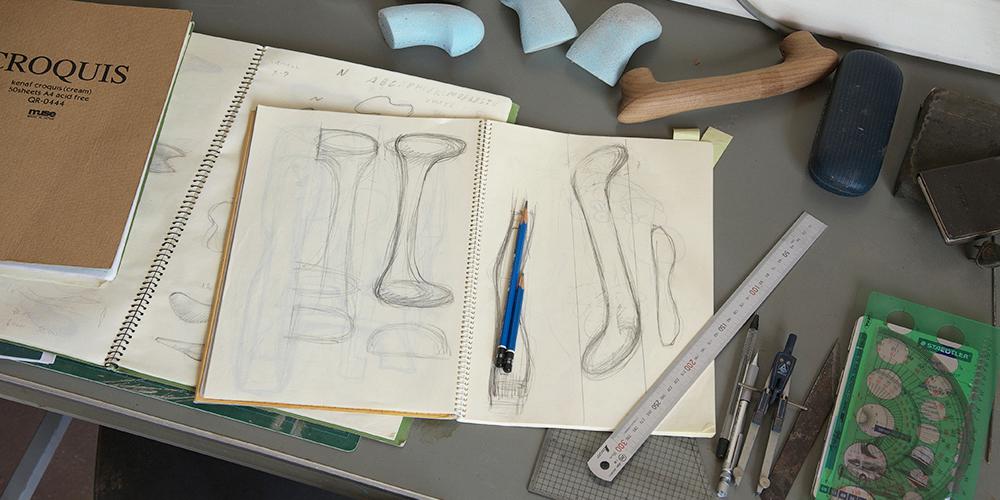Giving Shape to Movements
Beautiful shapes created in forms of people whose aim is to live with beauty.
Making the ordinary actions of users beautiful through the design of shapes.
This is the spirit of the SUGATA KATACHI brand name.
We are Makiko Takahashi, a creator of fabric products, and Yasufumi Takahashi,
a modern artist. We have both worked and studied in Europe and the United States.
When we returned home from New York in 2005, we rediscovered the refined movement
and manner of the Japanese, as exemplified by gardens, the tea ceremony, and calligraphy.
With designs that "give shape to movements", we set out to create objects that are unique,
of good quality, and which can be part of your life for many, many years.
We'd like to contribute to the creation of beautiful living spaces with the concept of
"Shapes Created in Forms of People Whose Aim is to Live with Beauty."
Giving Shape to Movements
Beautiful shapes created in forms of people whose aim is to live with beauty. Making the ordinary actions of users beautiful through the design of shapes. This is the spirit of the SUGATA KATACHI brand name.
We are Makiko Takahashi, a creator of fabric products, and Yasufumi Takahashi, a modern artist. We have both worked and studied in Europe and the United States. When we returned home from New York in 2005, we rediscovered the refined movement and manner of the Japanese, as exemplified by gardens, the tea ceremony, and calligraphy. With designs that "give shape to movements", we set out to create objects that are unique, of good quality, and which can be part of your life for many, many years. We'd like to contribute to the creation of beautiful living spaces with the concept of "Shapes Created in Forms of People Whose Aim is to Live with Beauty."
Aiming for a Sustainable Society
The majority of door handles currently available on the household equipment market are made of metal. While they offer good durability, metal door handles consume large amounts of electrical power and fossil fuel in their manufacturing, ranging from the mining of raw materials to machining. This leads to very large amounts of carbon dioxide emissions, and means that they impose a high environmental load. When we compare aluminum with kiln-dried hardwood in terms of the amount of energy required to create them (in megajoules or Mj), we find that the ratio is 170 to 2. Compared to metal, the American hardwood that we at SUGATA KATACHI mainly use is produced from natural forests with diversified ecosystems. Furthermore, it stores 1.6 kg of carbon dioxide per each kg of wood. The total amount of greenhouse gases emitted in the process from logging, through lumber sawing and kiln-drying, to transportation to Japan is a mere 0.7 kg, making the environmental load of the wood very low. By replacing not only door handles but also other fittings, furniture, and buildings with wooden counterparts once again, using superb designs and master craftsmanship, SUGATA KATACHI aims to promote a reduction in carbon dioxide emissions, so as to contribute to the creation of a sustainable society.
The Master Is a Human Being.
The creation of a "SUGATA KATACHI" wooden door handle starts with a pencil sketch. Then, we search for the ideal form through a study (trial production), in which we carve a full-scale mockup out of a block of rigid urethane. Once we settle on a design, we reproduce it on pattern paper, trace it onto a wooden board, and then cut the wood with a band saw. We fasten the wooden blank in a vice, and then carve it with a chisel, shape it with a wood file, and finally polish it with sandpaper. We repeat these processes as many times as necessary until we are satisfied. We allow the newly fabricated patterns to age for a while, like wine, and then examine them.Only when one of them has been selected will a prototype be produced. All of this is done entirely by hand.
Of course, because of their asymmetrical, smooth three-dimensional curves, "SUGATA KATACHI" wooden door handles are not suitable for mass production. Unlike objects created with straight lines only, forms like abstract sculptures will have different nuances when created by different people, making the division of labor difficult. We had no alternative other than to make sure that the same creator hand-made them, one at a time, in the studio.
We have, however, started to use computers because we wanted more people to experience and use our products. We bring a prototype created by hand into a 3D drawing, operate the machine, and shave wood as if to run over it, by imitating the original creator. The final steps still rely on hand work, however. While checking the grip by hand, we carefully hone the form and finish it to bring out the beautiful wood grain texture.
We will never start the creation of a "SUGATA KATACHI" wooden door handle with a computer. Rather than falling into a trap that is the ease with which an object can be created with a machine, we'd like to teach the machine about shapes and how to leave "signs of movements" that can only be produced through hand work. The master is a human being even now.
Door Handles from a Country Where Chopsticks are the Norm
In Europe, there is a tradition of using metal cutlery such as knives, forks, and spoons, whereas in Japan, it is more common to use wooden chopsticks. Japanese people's sensitivities, influenced by the country's environment and food, are such that light and soft wood is preferred over metal to create chopsticks. Together with the "movements" related to the use of chopsticks, people have refined the materials, colors, and shapes of chopsticks. The texture you feel when you hold them in your hand. The gentle sensation you feel when they touch your lips and teeth. The affinity with your hand that makes you feelintegral with them whenever you use them. Nothing can surpass wood in terms of any of these features.
We would like to learn from such superb and refined wooden chopsticks to create wooden door handles and handrails that can evoke user's fresh sensitivities in their modern living spaces. There are excellent door handles available from around the world that are made of brass, glass, and porcelain. From now on, however, customers from over the world can also experience SUGATA KATACHI wooden door handles and handrails, made in the country where people prefer chopsticks.
Excellent in terms of esthetics and affinity with the human body, while being safe and incurring a very low environmental load, SUGATA KATACHI products are already used in JR Kyushu's Seven Stars in Kyushu sleeper train, a Japanese first-class cruise train, a five-star resort hotel in the French Alps, upscale boutiques in Costa Rica and Brussels, and elsewhere.
Door handles as a human interface
Human beings feel the world through the 5 senses: the sight, the hearing, the touch, the smell and the taste; and they are also able to convey information to others with their voice or body. All the objects that connect people to their environment are called "human interfaces". These are for example the pedals and the handlebars of a bike, or the screen, the keyboard and the mouse of a computer. Yet, these interfaces are not exclusive to the relations between humans with the machines, quite the contrary, they affect all the domains linked to the conception of living spaces. What is clearly noticeable is the common point shared by most of these interfaces: they must be touched to be used.
Most of the traditionnal construction materials: wood, stone, paper, fabric and leather are now replaced by artificial or imitation ones, with an identical look. And this trend of visual reproduction of materials and textures is settled in Japan too. However, in the inside of a room which actually is a human interface, the sense of touch is necessary for someone to feel comfortable, and this very sense is often difficult to satisfy when the only focus of the immitation materials is the sight. In this case, what kind of contact makes you feel comfortable in a space?
We believe that this is due to the natural impression of fluctuation of the material used. And it is indeed important to see this gentle fluctuation while looking at the wood grain, the surface of the rock, the paper or the fabric, but first of all, there is to feel physically the form and the texture. In another hand, it is true that there are surprisingly few places in life spaces where sensations can be felt. What a wide surface may contain are not the walls, neither the floor or the ceilling. If we pay attention to it, the inside of an entrance is filled with many elements: the door handles, and the furnitures ones, the coat hangers, the chairs, etc. Among these rigid or frail, curved or angular shapes, all possess this irregular movement, this distinctive relief of texture and shape, and it is this very difference that brings the most important comfort in everyday life. This is especially true when it comes to door handles, as it is one of the most manipulated parts in a home.
Additionally, when these handles are integrated to the doors and drawers, a comfortable movement is necessary. And it is important to design this "movement" in the living space by considering the floor, the walls, the ceiling and even the lighting as complementary elements in order to create an aesthetic combination. This rustic style trend is particularly characterised by the impression of simplicity that gives the interior, like the one which remains after the work of a craftsman. It is this style that is probably the closest to the purpose of our handles.
Charm of
SUGATA KATACHI Wooden Door Handles
1. The distinctive forms are designed by considering the movement of the handthat grips the door handle, such that the design has an asymmetrical, smooth, three-dimensional curve that is comfortable to hold and which naturally fits the hand.
2. Unlike a metal door handle, one fashioned from wood will never be hot in summer and cold in winter. The more you use it, the more glossy it will become and the more attached to it you will feel.
3. We use a simple and reliable mounting method, which allows you to mount the door handle to wooden, glass, and metal doors.
4. We conduct a wide range of tests to ensure that the door handle is sufficiently strong. By merely replacing the screws, you can mount the door handle to a pillar to act as a grab handle.
5. Our door handles have been recognized for their high quality, as exemplified by the fact that they are used in all the rooms of JR Kyushu’s "Seven Stars in Kyushu" sleeper train, the world’s first-class "cruise train."










